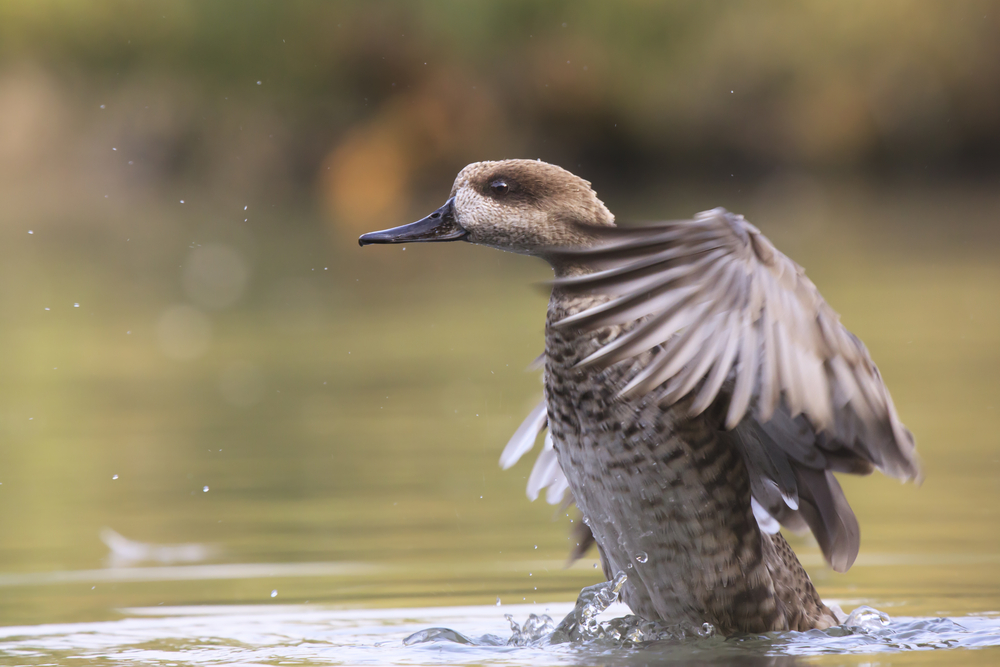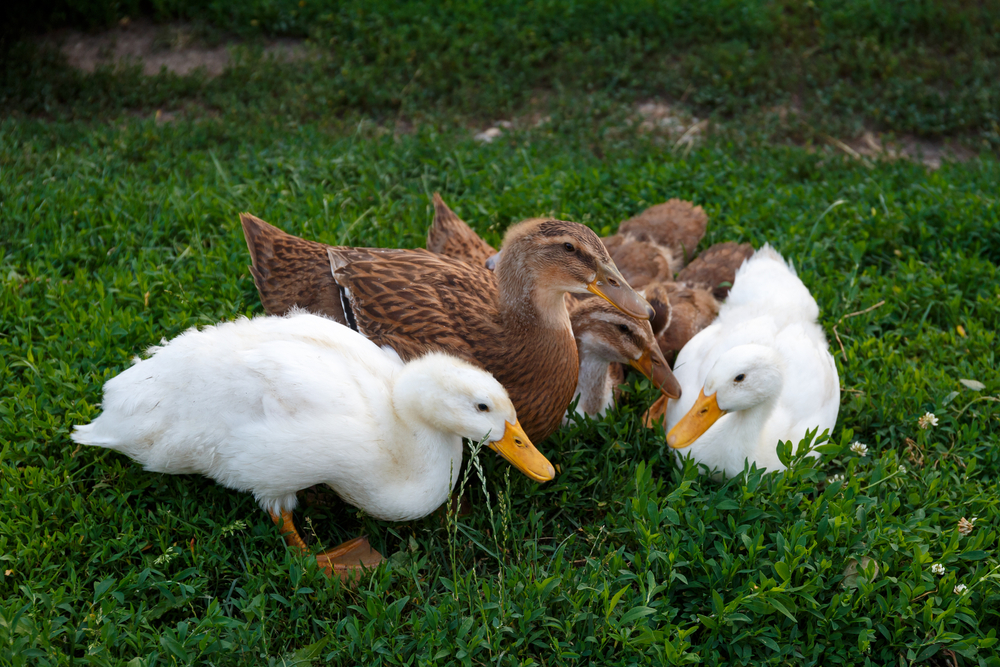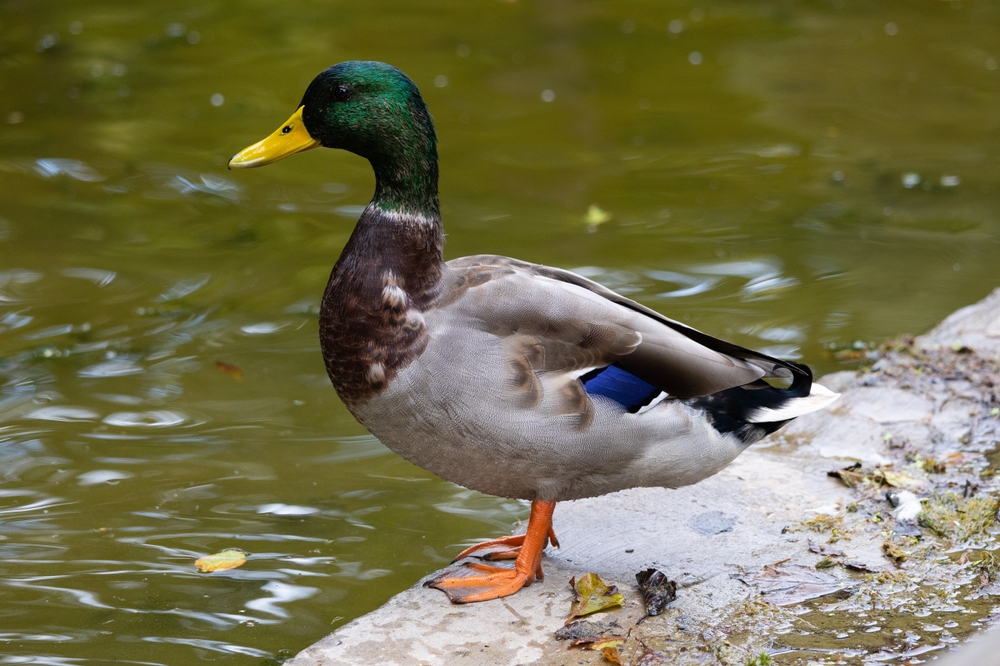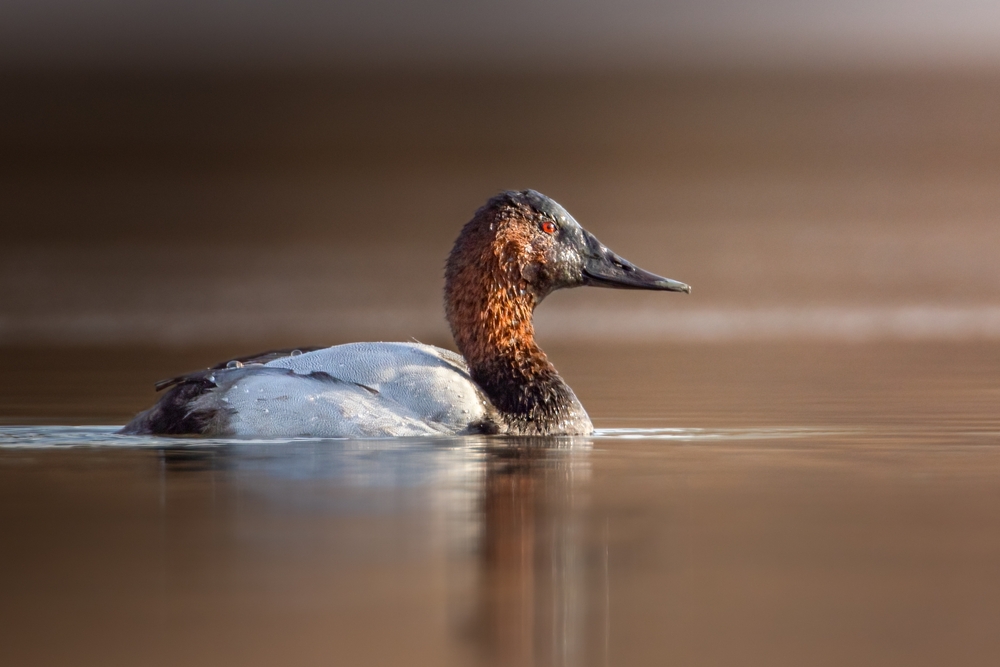There’s no close living sister species (it’s monotypic), but phylogenetic work places Marmaronetta as sister to the pochards—genera Netta and Aythya (e.g., Red-crested and Common Pochard).
About
The Marbled Duck (Marmaronetta angustirostris), also known as the Marbled Teal, is a medium-sized dabbling duck of the family Anatidae. Native to southern Europe, North Africa, and parts of the Middle East and Asia, it favors shallow wetlands, marshes, lagoons, and reservoirs with dense vegetation. This species is especially notable for its mottled, marbled plumage, which provides excellent camouflage in its watery habitats.
Measuring about 39–42 cm (15–17 in) in length with a wingspan of 63–70 cm (25–28 in), the Marbled Duck is smaller than a Mallard but slightly larger than a teal. Both sexes look similar, cloaked in light brown and cream mottled plumage with a pale face and dark eye stripe. Their slender, elongated bodies and relatively long tails give them a distinctive profile compared to other dabbling ducks.
Marbled Ducks are omnivorous, feeding on seeds, aquatic plants, and small invertebrates. They forage by dabbling at the water’s surface or tipping forward in shallow areas. In flight, their pale underwings and agile movement distinguish them from other waterfowl.
Breeding typically occurs in spring, with pairs nesting in dense reeds or shrubs near water. The nest, a shallow scrape lined with down and vegetation, shelters a clutch of 7–10 creamy white eggs. Ducklings are precocial, leaving the nest shortly after hatching to follow the female and feed themselves.
The Marbled Duck has declined significantly due to wetland drainage, water diversion, hunting, and disturbance. Today, it is classified as Vulnerable on the IUCN Red List. Conservation efforts focus on protecting and restoring wetland habitats across its range, especially in Spain, North Africa, and the Middle East.
Despite its rarity, the Marbled Duck is admired for its delicate beauty and ecological importance as part of fragile wetland ecosystems.
Physical Characteristics
The Marbled Duck (Marmaronetta angustirostris) is a lightly built, sand-colored dabbling duck with delicate mottling and a peaked crown.
Head & Bill
Small, gently rounded head with a subtle rear peak/crest, giving a slightly elongated profile. Bill is fairly long, straight, and gray to slate with a smooth, even breadth.
Plumage
Overall pale sandy-buff to gray-buff finely marbled with creamy spots and vermiculations across the head, neck, back, and flanks. Face often a shade paler; dark eye stands out without bold facial lines. Sexes are similar; males only slightly larger and cleaner-toned. Juveniles show warmer brown tones with looser spotting.
Body
Slender, low-riding body with soft contours; breast and flanks finely patterned rather than contrasting blocks of color. Underwings pale; upperwing shows muted contrast (speculum is inconspicuous compared with many ducks).
Wings
Narrow, pointed wings suited to fast, direct flight. In good light, upperwing coverts and secondaries show subtle pale and gray contrasts; no bold color panel.
Tail
Short and slightly rounded, aiding a streamlined outline on the water.
Legs & Feet
Gray to dusky legs; webbed feet placed slightly rearward for efficient paddling and short, low “tip-up” feeds.
Size
-
Length: 15–17 in (39–43 cm)
-
Wingspan: 25–28 in (64–71 cm)
-
Weight: 1.0–1.5 lbs (450–700 g)
The Marbled Duck’s fine, all-over marbling, peaked crown, and lack of bold wing or head patterns distinguish it from other pale dabbling ducks.
Reproduction
The Marbled Duck (Marmaronetta angustirostris) breeds in shallow, vegetated wetlands of the Mediterranean, North Africa, and West–Central Asia. Its cycle follows the classic dabbling-duck pattern—seasonal pairing, ground nests, female-only incubation, and precocial young.
Mating and Courtship
Pairs form in late winter to spring on staging wetlands. Courtship is subtle—head dips, short pursuit flights, and quiet calls. Pair bonds are seasonal; the drake leaves once incubation begins.
Breeding Season
Timing varies with water levels. In the Mediterranean it peaks April–July; in drier regions nesting often follows spring–early summer fill of temporary marshes.
Nesting
The female selects a concealed ground site in dense sedges, rushes, tamarisk, or reed tussocks, usually close to water or on low islets. She builds a shallow cup of dry vegetation and lines it with down plucked from her breast.
Eggs
Typically 7–10 smooth, creamy to buff eggs (range 6–12). Each egg is roughly ~2.0–2.2 in (5.1–5.6 cm) long.
Incubation
Female-only incubation lasts ~25–27 days. She leaves briefly to feed, covering the clutch with down for camouflage.
Chick Development
Ducklings hatch precocial—downy, eyes open, and mobile within hours. The hen leads them to food-rich shallows the day of hatching or the next. Young feed themselves on small aquatic invertebrates and plant matter; the female provides brooding and defense.
Fledging and Independence
Wing growth to first flight takes ~45–55 days (about 6–8 weeks). Families then disperse as juveniles gain full flight and independence.
Broods per Year & Re-nesting
Usually one brood annually; hens commonly re-nest if an early clutch fails, provided suitable water persists.
Special Notes
As a wetland specialist with variable breeding tied to water availability, the species’ productivity fluctuates strongly with rainfall and marsh management.
Lifespan
The Marbled Duck (Marmaronetta angustirostris) has moderate longevity typical of small dabbling ducks, with survival closely tied to water availability and wetland quality.
Lifespan in the Wild
Commonly 4–7 years for birds that survive their first year; many juveniles perish from predation, drought, or habitat loss. A few individuals can reach ~10–12 years in favorable conditions.
Lifespan in Captivity
Seldom kept; where legally maintained with balanced diet, veterinary care, and spacious, clean ponds, similar-sized ducks often reach 10–14 years. Verified captive records for this species are limited.
Threats to the Marbled Duck
-
Habitat loss & water management: Drainage, damming, and altered hydroperiods reduce nesting and brood habitat.
-
Drought & climate variability: Temporary marshes dry before fledging; food pulses fail.
-
Hunting & lead exposure: Illegal take and legacy lead shot/tackle cause direct and sub-lethal mortality.
-
Disturbance & predation: Human activity, invasive predators, and egg predation lower recruitment.
-
Disease & pollution: Botulism outbreaks and poor water quality impact survival on crowded refuges.
Securing large, seasonally flooded wetlands, managing water levels for breeding, removing lead, and protecting quiet brood areas help Marbled Ducks reach the upper end of their lifespan.
Eating Habits
The Marbled Duck (Marmaronetta angustirostris) is an omnivorous dabbler that feeds in shallow, vegetated wetlands where calm water and soft substrates concentrate food.
Diet
Small aquatic invertebrates (chironomid larvae, beetles, amphipods, snail eggs), zooplankton, and a substantial share of plant matter—seeds of sedges and grasses, pondweeds, bulrush, and tender shoots/algae. Ducklings rely more on protein-rich invertebrates.
Foraging Strategy
Primarily surface feeding and tip-up dabbling in water typically ankle- to knee-deep for a duck. Also picks along muddy margins and probes soft bottoms for larvae and seeds.
Feeding Mechanics
Broad, lamellate bill filters suspended particles. The tongue pumps water through the “comb” edges while trapping edible bits; sensitive bill nerves help detect prey in turbid water.
Daily Rhythm
Most active at dawn and dusk; night feeding increases on disturbed or hot days when wetlands are busy or water warms.
Seasonal Shifts
-
Breeding season: higher proportion of insects and other invertebrates to support egg formation and duckling growth.
-
Post-breeding/autumn: more seeds and vegetative matter as wetlands draw down and seed heads mature.
-
Drought years: opportunistic switching to whatever persists in shrinking pools (larval swarms, stranded seed beds).
Social Feeding
Forages in small groups or loose flocks, often mixed with other dabblers. Individuals watch conspecifics to locate productive patches but show little overt aggression where food is widespread.
Habitat & Depth
Prefers shallow, densely vegetated marshes, temporary floodplains, and quiet lagoon edges with soft bottoms; typically feeds where tip-ups reach the substrate without diving.
Energy Notes
Light build and warm-climate wetlands reduce thermoregulatory costs, but fluctuating water levels can force frequent moves. Access to undisturbed shallows rich in emergent plants is critical for efficient intake, especially for broods.
Uniqueness
The Marbled Duck (Marmaronetta angustirostris) is a subtle, sand-toned dabbler adapted to ephemeral wetlands.
Monotypic lineage
The only species in its genus—an evolutionary outlier among dabbling ducks.
All-over marbling
Fine, creamy speckles across head, neck, and body create exceptional camouflage in pale reedbeds and salt-steppe lagoons.
Peaked crown silhouette
A gently elongated rear crown forms a soft “crest,” giving a distinctive, small-headed, long-necked look.
Muted wings—no bold speculum
Lacks the flashy wing panels common in many ducks; the understated upperwing helps it remain inconspicuous in flight.
Ephemeral-wetland specialist
Breeds in shallow, vegetated, often brackish marshes that fill after rains; productivity tracks water levels closely.
Nomadic tendencies
Irruptive local movements follow shifting water and food, producing sudden appearances and disappearances at traditional sites.
Quiet, low-profile behavior
Soft calls, discreet courtship, and low, skimming flight keep it under the radar compared with louder, gregarious dabblers.
Concealed ground nester
Chooses dense sedges, tamarisk, or reed tussocks near water; down-lined cups vanish into the vegetation.
Crepuscular feeder
Frequently feeds at dawn, dusk, and at night, when disturbance is lowest and invertebrates peak.
Conservation signal
Highly sensitive to drainage, altered hydrology, and disturbance—its presence indicates intact, seasonally managed marsh mosaics.
Be the First to Share Photos of This Species.
FAQ’s
1. What species is closest to the Marbled Duck?
2. How does the Marbled Duck compare to other ducks?
Smaller, pale, and finely marbled overall, with sexes looking alike and no bold wing speculum—unlike many dabbling ducks. It favors shallow, often brackish, vegetated wetlands, stays low-profile and crepuscular, and shows more nomadic, rain-driven movements than typical resident dabblers.
3. What national parks provide the best opportunities for seeing a Marbled Duck?
What national parks provide the best opportunities for seeing a Marbled Duck?
-
Doñana National Park, Spain — Holds breeding populations of Marbled Teal (Marbled Duck) in suitable water years.
-
Sultansazlığı (Sultan Marshes) National Park, Türkiye — Regular breeder and key wetland within the Anatolian flyway.
-
Ichkeul National Park, Tunisia — Major Western Palearctic waterfowl site where Marbled Duck occurs (wintering/breeding depends on conditions).
-
Khenifiss National Park, Morocco — Coastal lagoon with resident/wintering Marbled Duck reported.
-
Bakhtegan National Park & Lake Tashk–Kamjan, Iran — Historic breeding stronghold (highly water-level dependent).
-
Sultanpur National Park, India — Rare but documented winter vagrant (e.g., 2024 sighting after 30 years).
Note: Occurrence fluctuates with rainfall and water management; always check recent local reports before planning a focused search.






































































